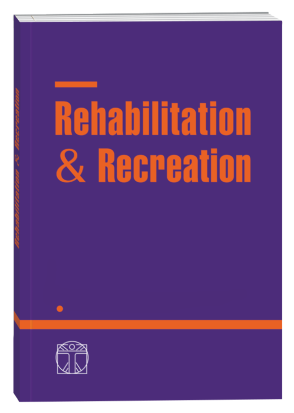ВІДМІННОСТІ В АКТИВНОСТІ М'ЯЗІВ НИЖНІХ КІНЦІВОК ПІД ЧАС ВИКОНАННЯ ВИПАДІВ У СПОРТСМЕНІВ-ФЕХТУВАЛЬНИКІВ ІЗ ТА БЕЗ ТРАВМ В АНАМНЕЗІ
DOI:
https://doi.org/10.32782/2522-1795.2025.19.2.18Ключові слова:
електроміографія, м'язова активність, травми нижніх кінцівок, гендерні відмінності, реабілітаціяАнотація
Мета роботи: Це дослідження мало на меті дослідити відмінності в активності м'язів нижніх кінцівок під час випадів у фехтувальників із травмами нижніх кінцівок та без них з акцентом на гендерні відмінності. Розуміння цих відмінностей може допомогти вдосконалити стратегії тренувань та реабілітації, адаптовані до потреб спортсменів. Методи та матеріали: Загалом було набрано 24 фехтувальники (12 чоловіків та 12 жінок) віком 15–24 років, яких було розділено на групи з травмами та без них. Для вимірювання активності семи м'язів нижніх кінцівок: прямого м'яза стегна, медіального широкого м'яза стегна, латерального широкого м'яза стегна, двоголового м'яза стегна, напівсухожильного м'яза, медіального литкового м'яза та латерального литкового м'яза під час випадів було використано поверхневу електроміографію (сЕМГ). Дані про м'язову активність проаналізовано за допомогою незалежних t-тестів у SPSS версії 26. Результати: У спортсменів-чоловіків у групі без травм спостерігалася значно вища м'язова активність прямого м'яза стегна, медіального широкого м'яза стегна, латерального широкого м'яза та латерального литкового м'яза (p < 0,05). Натомість спортсменки без травм у анамнезі показали значно більшу м'язову активацію прямого м'яза стегна, медіального широкого м'яза стегна, латерального широкого м'яза стегна, напівсухожильного м'яза стегна та медіального литкового м'яза (p < 0,05). Деякі групи м'язів, такі як двоголовий м'яз стегна та напівсухожильний м'яз у чоловіків та латеральний литковий м'яз у жінок, суттєво не відрізнялися між групами. Висновок: Травми нижніх кінцівок призводять до зниження м'язової активності під час випадів, причому ширші наслідки спостерігаються у спортсменок. Ці результати підкреслюють важливість урахування гендерних відмінностей у розробленні програм профілактики травм та реабілітації для спортсменів-фехтувальників.
Посилання
1. Alekseyev, K., Stoly, Y., Chang, R., Lakdawala, M., Bijlani, T., Cristian, A. (2016). Identification of the most frequent injuries in a variety of fencing competitors: A cross sectional study of fencing clubs in the Northeast tri-state region. Physical Medicine and Rehabilitation Research, 1(3). https://doi.org/10.15761/PMRR.1000115
2. Aresta, S., Bortone, I., Bottiglione, F., Di Noia, T., Di Sciascio, E., Lofù, D., Musci, M., Narducci, F., Pazienza, A., Sardone, R., Sorino, P. (2022). Combining Biomechanical Features and Machine Learning Approaches to Identify Fencers’ Levels for Training Support. Applied Sciences (Switzerland), 12(23). https://doi.org/10.3390/app122312350
3. Beckwée, D., Cuypers, L., Lefeber, N., De Keersmaecker, E., Scheys, E., Van Hees, W., Perkisas, S., De Raedt, S., Kerckhofs, E., Bautmans, I., Swinnen, E. (2022). Skeletal Muscle Changes in the First Three Months of Stroke Recovery: A Systematic Review. Journal of Rehabilitation Medicine, 54, jrm00308. https://doi.org/10.2340/jrm.v54.573
4. Chen, T.L.-W., Wong, D.W.-C., Wang, Y., Ren, S., Yan, F., Zhang, M. (2017). Biomechanics of fencing sport: A scoping review. PLOS ONE, 12(2), e0171578. https://doi.org/10.1371/journal.pone.0171578
5. Chida, K., Inami, T., Yamaguchi, S., Yoshida, Y., Kohtake, N. (2024). Effects of Different Target Distances on the Kinematics of Hip, Knee, and Ankle Joints in the Fencing Lunge. Biomechanics, 4(2), 309–318. https://doi.org/10.3390/biomechanics4020020
6. Chung, J.-W., Lim, B.-O., Cho, J.-H., Lee, K.-H. (2020). Prevalence of sports injuries in Korean fencers aged 14-40 years. The Journal of Sports Medicine and Physical Fitness, 60(10), 1371–1376. https://doi.org/10.23736/S0022-4707.20.10900-9
7. Cross, E.R., Lynch, S.M., Miller, P.E., Hunt, D.L., Stein, C.J. (2024). Injury Patterns in Fencing Athletes – A Retrospective Review. International Journal of Sports Physical Therapy, 19(9), 1108–1115. https://doi.org/10.26603/001c.122322
8. Decoster, L.C., Scanlon, R.L., Horn, K.D., Cleland, J. (2004). Standing and Supine Hamstring Stretching Are Equally Effective. Journal of Athletic Training, 39(4), 330–334. https://doi.org/15592605
9. Dedieu, P., Salesse, M., Champain, G., Zanone, P.G. (2024). Comparing lunge techniques depending on the weapon used: Differences between foil and epee fencers. Journal of Physical Education and Sport, 24(4), 974–985. https://doi.org/10.7752/jpes.2024.04111
10. Deely, C., Tallent, J., Bennett, R., Woodhead, A., Goodall, S., Thomas, K., Howatson, G. (2022). Etiology and Recovery of Neuromuscular Function Following Academy Soccer Training. Frontiers in Physiology, 13. https://doi.org/10.3389/fphys.2022.911009
11. Drakoulaki, V., Kontochristopoulos, N., Methenitis, S., Simeonidis, T., Cherouveim, E., Koulouvaris, P., Savvidou, O., Tsolakis, C. (2021). Bilateral asymmetries in male and female young elite fencers in relation to fencing performance. Isokinetics and Exercise Science, 29(2), 113–121. https://doi.org/10.3233/IES-202200
12. Fournier, G., Bernard, C., Cievet-Bonfils, M., Kenney, R., Pingon, M., Sappey-Marinier, E., Chazaud, B., Gondin, J., Servien, E. (2022). Sex differences in semitendinosus muscle fiber-type composition. Scandinavian Journal of Medicine & Science in Sports, 32(4), 720–727. https://doi.org/10.1111/sms.14127
13. Gawande, R., To, M.N., Pine, E., Griswold, T., Creedon, T.B., Brunel, A., Lozada, A., Loucks, E.B., Schuman-Olivier, Z. (2019). Mindfulness Training Enhances Self-Regulation and Facilitates Health Behavior Change for Primary Care Patients: a Randomized Controlled Trial. Journal of General Internal Medicine, 34(2), 293–302. https://doi.org/10.1007/s11606-018-4739-5
14. Greenhalgh, A., Bottoms, L., Sinclair, J. (2013). Influence of Surface on Impact Shock Experienced During a Fencing Lunge. Journal of Applied Biomechanics, 29(4), 463–467. https://doi.org/10.1123/jab.29.4.463
15. Harmer, P.A. (2019). Epidemiology of time-loss injuries in international fencing: a prospective, 5-year analysis of Fédération Internationale d’Escrime competitions. British Journal of Sports Medicine, 53(7), 442–448. https://doi.org/10.1136/bjsports-2018-100002
16. Ji, Y., Li, M., Chang, M., Liu, R., Qiu, J., Wang, K., Deng, C., Shen, Y., Zhu, J., Wang, W., Xu, L., Sun, H. (2022). Inflammation: Roles in Skeletal Muscle Atrophy. Antioxidants, 11(9), 1686. https://doi.org/10.3390/antiox11091686
17. Klarod, K., Surakul, P. (2020). Mechanism of muscle injury from eccentric exercise induced free radicals and protection with antioxidants. Chulalongkorn Medical Journal, 64(3), 347–354. https://doi.org/10.14456/clmj.2020.43
18. Kurniawan, A., Santosa, T., Priya, N., Santoso, B. (2023). Analysis of Surface Electromyography of the Quadriceps Muscle During Lunge Movements in the Sport of Fencing With a History of Knee and Quadriceps Corner Pain (Q-Angle). JISEAPE Journal Of Indonesia Sport Education And Adapted Physical Education, 4(1), 1–13. https://ejournal.utp.ac.id/index.php/JISEAPE
19. Lee, H.S., Lee, D.J., Baek, K.W., Lee, A., Park, Y., Kim, J.S. (2024). Effects of Pilates-Combined Training on the Improvement of Flexibility and Pain Relief in Elite Fencers. Exercise Science, 33(2), 131–139. https://doi.org/10.15857/ksep.2024.00129
20. Meagher, C., Franco, E., Turk, R., Wilson, S., Steadman, N., McNicholas, L., Vaidyanathan, R., Burridge, J., Stokes, M. (2020). New advances in mechanomyography sensor technology and signal processing: Validity and intrarater reliability of recordings from muscle. Journal of Rehabilitation and Assistive Technologies Engineering, 7, 2055668320916116. https://doi.org/10.1177/2055668320916116
21. Park, K.J., Byung, S.B. (2017). Injuries in elite Korean fencers: An epidemiological study. British Journal of Sports Medicine, 51(4), 220–225. https://doi.org/10.1136/bjsports-2016-096754
22. Santoso, N.P.B., Dewangga, M.W., Hutomono, S., Sulistyono, J., Herywansyah, H., Adhitama, Y.M., Kurniawan, A. (2023). The impact of knee pain on body balance and electromyographic activity of the quadriceps muscle in fencers during the lunge movement. Fizjoterapia Polska, 23(3), 26–31. https://doi.org/10.56984/8ZG143F33
23. Sinclair, J., Bottoms, L. (2013). Gender differences in the kinetics and lower extremity kinematics of the fencing lunge. International Journal of Performance Analysis in Sport, 13(2), 440–451. https://doi.org/10.1080/24748668.2013.11868660
24. Swatowska, M.M., Akbaş, A., Juras, G. (2020). Injuries in high-performance fencers – a review. In Archives of Budo (Vol. 16, pp. 261–269).
25. Thompson, K., Chang, G., Alaia, M., Jazrawi, L., Gonzalez-Lomas, G. (2022). Lower extremity injuries in U.S. national fencing team members and U.S. fencing Olympians. The Physician and Sportsmedicine, 50(3), 212–217. https://doi.org/10.1080/00913847.2021.1895693
26. Wijianto, W., Agustianti, E.F. (2022). The Effect of Active and Passive Recovery Exercise in Reduring Doms (Delayed Onset Muscle Soreness): Critical Review. Gaster, 20(1), 111. https://doi.org/10.30787/gaster.v20i1.773
27. Zhang, Y., Hu, Z., Li, B., Qiu, X., Li, M., Meng, X., Kim, S., Kim, Y. (2023). Gender Differences in Lower Extremity Stiffness during a Single-Leg Landing Motion in Badminton. Bioengineering (Basel, Switzerland), 10(6). https://doi.org/10.3390/bioengineering10060631
##submission.downloads##
Опубліковано
Як цитувати
Номер
Розділ
Ліцензія

Ця робота ліцензується відповідно до Creative Commons Attribution-NonCommercial-NoDerivatives 4.0 International License.





